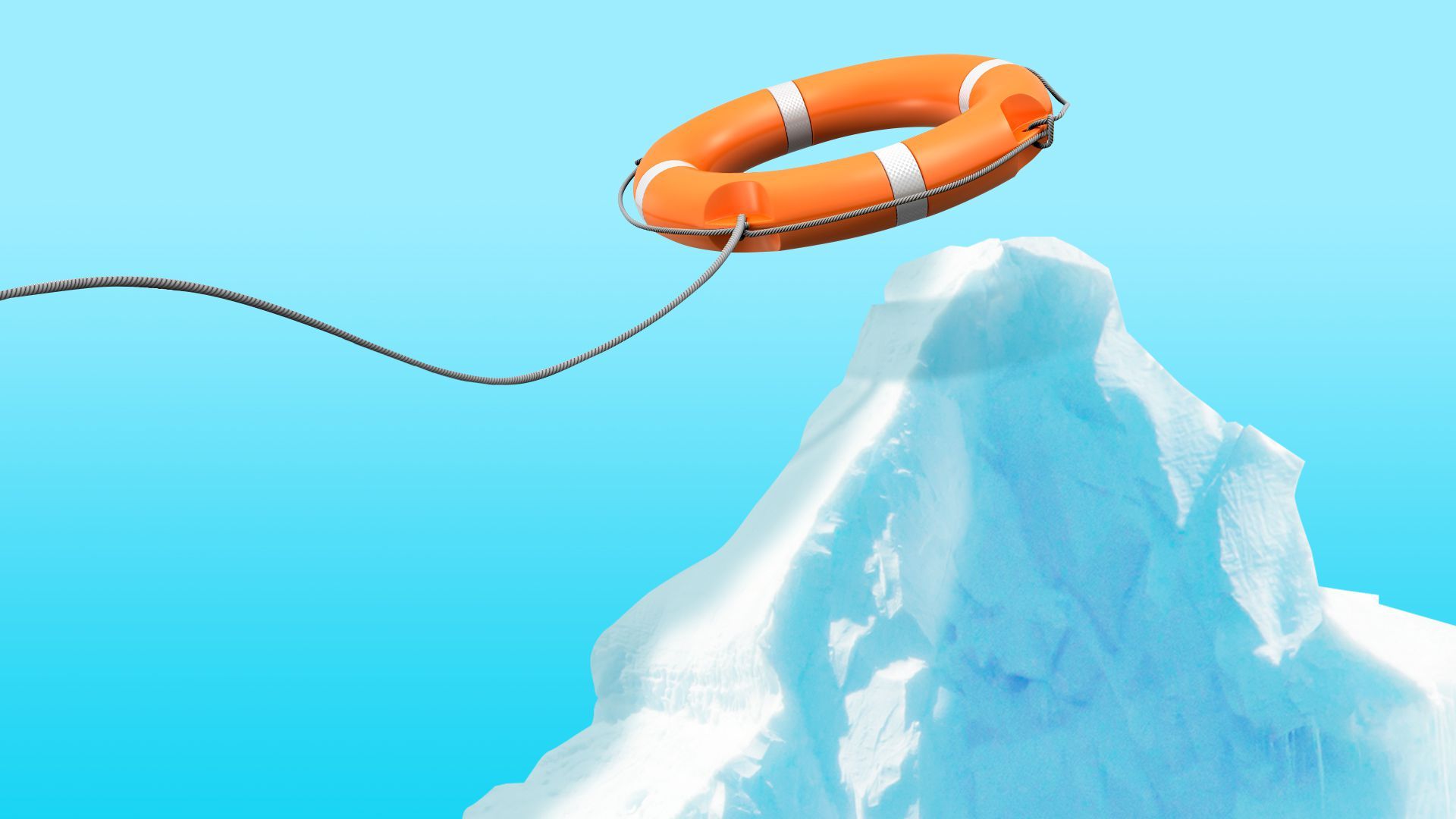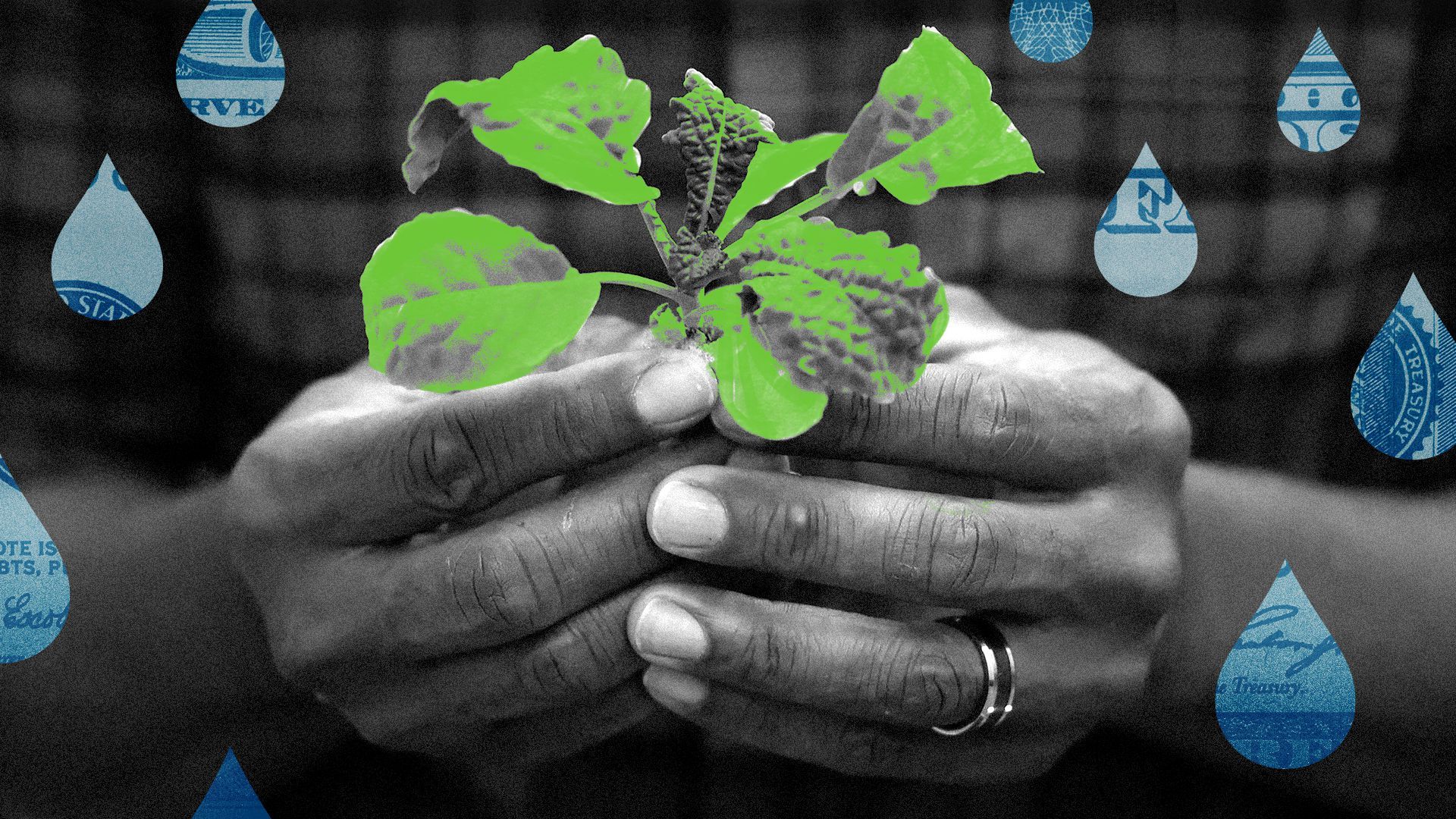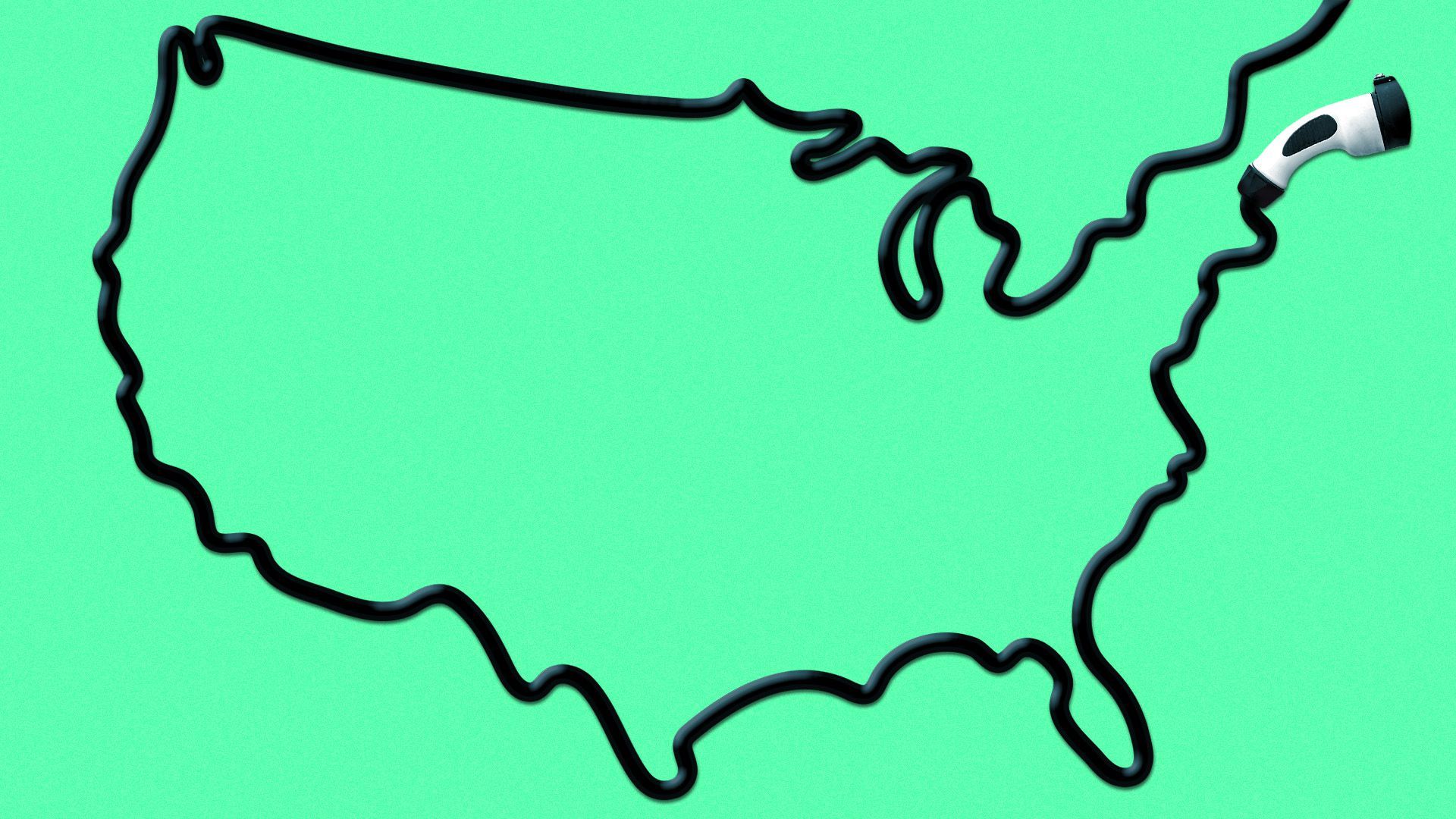| | | | | | | Presented By Enbridge | | | | Axios Generate | | By Ben Geman and Andrew Freedman · Jan 06, 2023 | | 🍺 Oh yes. Friday. Today's newsletter has a Smart Brevity count of 1,235 words, 5 minutes. 🎶 At this moment in 2000, Donell Jones and the late Lisa "Left Eye" Lopes were #1 on Billboard's R&B chart with today's irresistible intro tune... | | | | | | 1 big thing: A glacial melt dilemma |  | | | Illustration: Aïda Amer/Axios | | | | A major new study on the precarious future of the world's glaciers illustrates how scientists, advocates and journalists often struggle to communicate effectively about global warming, Andrew writes. The big picture: One framing of the study, published in the journal Science, suggests there is still time to save tens of thousands of Earth's glaciers if we were to act now to slash emissions. - Another view is that even if global warming is held to just 1.5°C above preindustrial levels, a tall order, we'd still lose about half the world's glaciers by 2100.
- That first portrayal has hope, which comes across in part of the study's title, "Every increase in temperature matters."
- The other is stark.
Context: To be clear, the state of the planet's glaciers is grim. - The vast majority are melting and shrinking in response to higher temperatures, greater rainfall and increased ocean temperatures.
- The new study gives a fresh look at every glacier's fate in a warming world, providing new melt projections and regional details.
What they found: Using computer modeling that incorporates different scenarios of future emissions and temperature change, the study projects that glaciers may lose 26% of their mass by 2100, compared to 2015, if air temperatures reach 1.5°C above preindustrial levels. - Global glaciers could lose about 41% of their mass, compared to 2015, if warming were to reach 4°C (7.2°F) above preindustrial levels by 2100.
- These figures mean that between 49% and 83% of the world's more than 215,000 glaciers would disappear by the end of the century, depending on the amount of warming.
Threat level: Several recent studies have shown that even if countries meet their emissions reduction pledges made at COP26 and COP27, the world would warm between about 2°C and 3°C by 2100. - This would "cause widespread deglaciation in most mid-latitude regions by 2100," the study states.
Yes, but: The study shows there is a linear relationship between ice mass loss and temperature, which means less warming translates directly into lower ice loss. - "But we're really trying to show that our actions as a society can have a big impact on reducing that additional mass loss and really save a lot of ice that's on our planet," lead author David Rounce of Carnegie Mellon University, told Axios in an interview.
- Still, others struck a far more somber tone. "We keep repeating the same message about glacier loss," said Eric Rignot, a researcher at the University of California at Irvine who was not involved in the study.
- "This is bad, bad news. And every 1/10th degree of warming makes it worse."
|     | | | | | | 2. Indoor farming isn't just for the rich |  | | | Photo illustration: Shoshana Gordon/Axios. Photo: Antonio Perez/Chicago Tribune/Tribune News Service via Getty Images | | | | Historically costly indoor hydroponic farms are becoming more accessible to small-scale U.S. farmers, Axios' Ayurella Horn-Muller reports. Why it matters: While extreme weather exacerbated by climate change hurts crop yields, some small farmers are turning to ag-tech solutions that have long been sequestered from anyone but the rich. The big picture: Indoor hydroponic farms, or just indoor farms, are tech-driven, weather-controlled production sites that grow crops in nutrient solutions rather than soil. - They use less water than traditional farming methods and take up less space — and are popping up everywhere from Alabama to Hawaii.
- Axios' Jennifer Kingson writes that while indoor growing can't completely replace outdoor growing for crops like lettuce, it's expected to start filling in when climate change leads to more crop failures.
- Nearly two-thirds of farmers surveyed across 15 U.S. states reported significant crop and income loss due to drought conditions last year, per the American Farm Bureau Federation.
What they're saying: According to Nona Yehia, CEO and co-founder of Vertical Harvest Farms, indoor farming has long been associated with a major barrier to access — high startup and operating costs. - "As we grow as an industry, that cost is going to come down ... but I think that's going to take time," says Yehia.
Read the whole story |     | | | | | | 3. Oil market tightness isn't going away |  Moody's Investors Service and International Energy Agency; Chart: Thomas Oide/Axios "Restrained capital spending will keep oil and gas supply tight and prices strong in 2023," Moody's Investors Services predicts, Ben writes. The big picture: Exploration and production spending is slated to rise, but will remain well below the mid-2010s levels. Moody's analysis expects a cumulative $460 billion-$480 billion industry upstream investment this year. Why it matters: It's one reason the market will be volatile amid a delicate supply-demand balance, it finds. How it works: "More than half of the incremental spending in 2023 will go just to cover cost inflation, leaving relatively little capital for volume growth," Moody's Sajjad Alam writes. - In addition, producers "will try to follow the same playbook in 2023 that yielded strong financial results in 2022."
- Expect "capital restraint," prioritizing shareholder returns and shoring up balance sheets.
👀 Speaking of oil, Bloomberg's Jennifer Dlouhy delivers some policy news... "The Biden administration is deferring a plan to crack down on smog in the drilling hotbed of the Permian Basin, handing a win to oil producers along with their allies in Texas and New Mexico." |     | | | | | | A message from Enbridge | | Can coral reefs help fight climate change? | | |  | | | | Enbridge's support is helping the University of Texas Rio Grande and Friends of RGV Reef determine if reefs can capture and store carbon. Why it's important: This is "a potential game-changer for the planet" in dealing with climate challenges. Read more. | | | | | | 4. Mercedes makes its move on EV charging |  | | | Image courtesy of Mercedes-Benz | | | | Mercedes-Benz plans to build a branded charging network in North America with a goal of over 2,500 chargers by 2027 grouped in 400 "hubs," Ben writes. Why it matters: Auto giants pouring billions into electrifying their lineups need to assure buyers that charging is fast and accessible. The intrigue: Carmakers have different strategies, with some giants like Ford and GM so far steering clear of building their own branded networks. Zoom in: Mercedes is working with renewables and storage provider (and Goldman Sachs spinoff) MN8 Energy and EV charging company ChargePoint. - The $1 billion expected cost is split 50-50 with MN8, per the announcement yesterday.
- Mercedes drivers will get "preferential access via a reservation function," but the chargers will be available to other brands.
- "The companies said they planned to apply for federal subsidies available to companies that build chargers," the NYT reports.
|     | | | | | | Bonus EV notes: Ford and Amazon |  | | | Illustration: Shoshana Gordon/Axios | | | | 📈 Ford Motor said yesterday its EV sales last year rose 126% to 61,575, Ben writes. - Driving the news: Ford is the No. 2 U.S. seller of EVs behind Tesla and the rising sales will help it hold onto that position.
- Zoom in: EVs remain a small share of major automakers' sales, but they're slated to move well beyond niche businesses soon. Ford plans to build 2 million EVs annually by 2026.
- The big picture: U.S. EV sales from all automakers combined jumped two-thirds last year to reach 5.8% of vehicles sold, the WSJ reports via the firm Motor Intelligence.
💬 Amazon announced yesterday that beginning later this year, "EV drivers in the U.S. will be able to ask Alexa to help them find and navigate to over 150,000 public charging stations." |     | | | | | | 5. Airlines can't just spend their way to net zero |  | | | Illustration: Maura Losch/Axios | | | | Delta's new climate initiative underscores how airlines will have to do more than open their wallets to achieve long-term emissions goals, Ben writes. Driving the news: Yesterday it announced the creation of an "innovation lab" to accelerate research, design and testing of sustainable tech. The lab will focus on cleaner fuel, efficiency, "revolutionary fleet concepts," and more. The intrigue: Delta, which has vowed "net-zero emissions" by 2050, is also investing in startups and the TPG Rise climate fund, among other steps. But the announcement gets to how airlines must also figure out how to develop and integrate new tech: It notes (emphasis added): "The Lab will lead the industry by going beyond financial investments, contributing Delta talent and know-how to ensure Delta is the airline of choice for disruptors hoping to test and launch their ideas." Axios' Joann Muller has more |     | | | | | | A message from Enbridge | | Our focus is on tomorrow | | |  | | | | At Enbridge, we're advancing the energy transition by investing in low-carbon solutions and modernizing our systems. The goal: By 2030, we plan to reduce the intensity of greenhouse gas emissions from our operations by 35%. By 2050, we plan to achieve net zero emissions. Find out more. | | | | 📬 Did a friend send you this newsletter? Welcome, please sign up. 🙏 Thanks to Mickey Meece and David Nather for edits to today's newsletter. Have a great weekend! |  | | Your personal policy analyst is here. | | | | | | Axios thanks our partners for supporting our newsletters.
Sponsorship has no influence on editorial content. Axios, 3100 Clarendon Blvd, Arlington VA 22201 | | | You received this email because you signed up for newsletters from Axios.
To stop receiving this newsletter, unsubscribe or manage your email preferences. | | | Was this email forwarded to you?
Sign up now to get Axios in your inbox. | | | | Follow Axios on social media:    | | | | | |











No comments:
Post a Comment